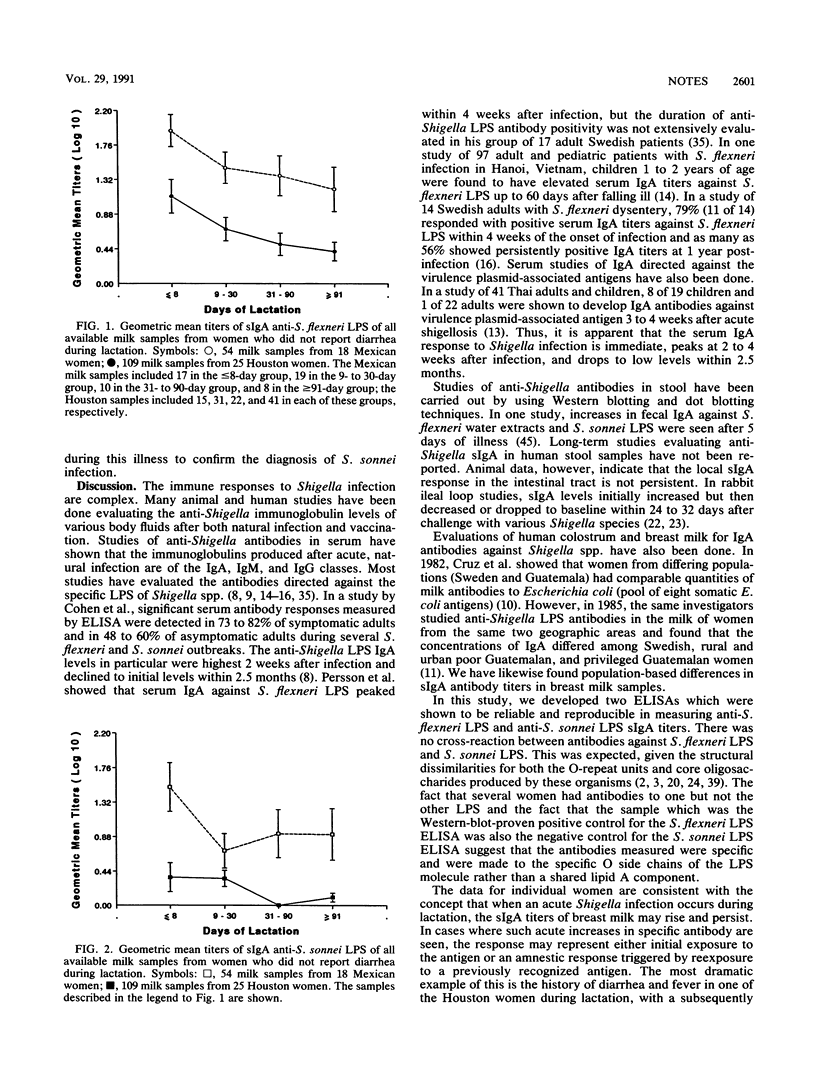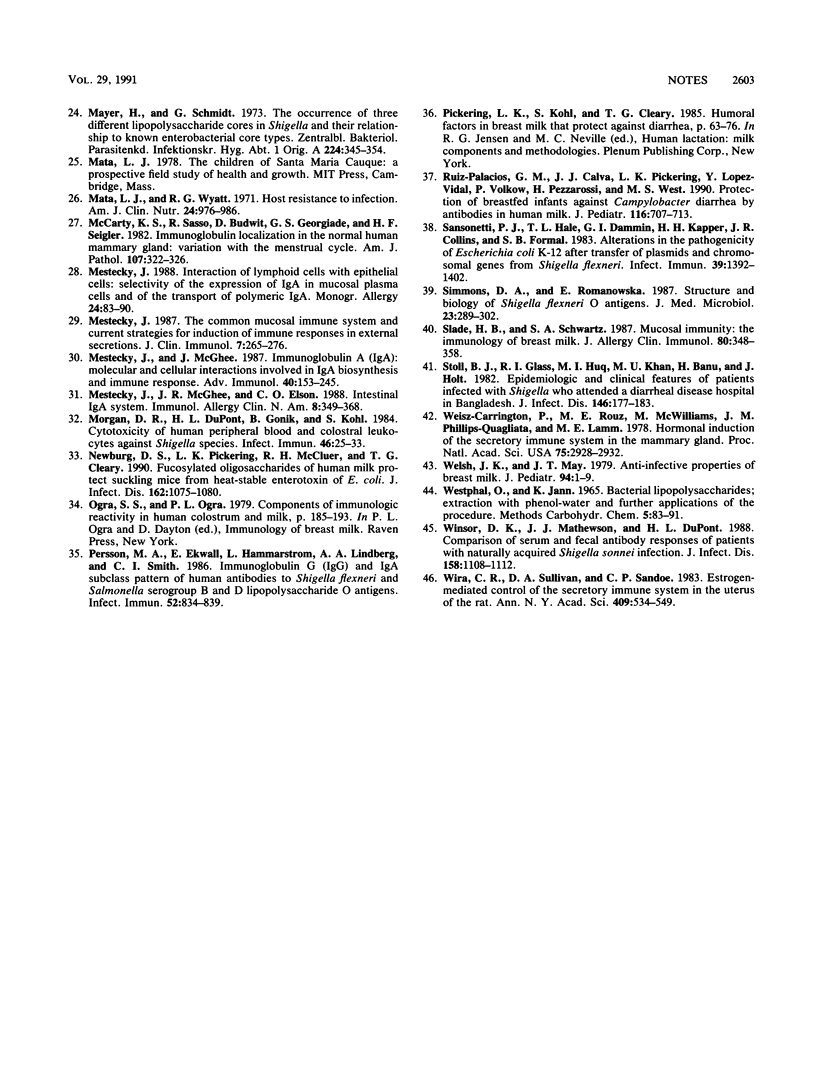Abstract
Although the common mucosal immune system has generally been considered to have only short-term memory, recent data suggest that long-term memory exists for Shigella virulence plasmid antigens. Because such antigens might cross-react with environmental antigens, we investigated milk for the persistence of antibodies to the specific Shigella lipopolysaccharide (LPS) antigens. Enzyme-linked immunosorbent assays to detect secretory immunoglobulin A (sIgA) against Shigella flexneri and Shigella sonnei LPS in milk samples were developed; 15 random milk samples tested on different days correlated from one day to the next (P = 0.0001). Of 18 Mexican mothers, 18 (100%) had one or more milk samples positive for anti-S. flexneri LPS, 14 (78%) had one or more milk samples positive for anti-S. sonnei LPS, and 14 (78%) had one or more milk samples positive for both. Of 27 Houston mothers, 16 (59%) had one or more milk samples positive for anti-S. flexneri LPS, 7 (26%) had one or more milk samples positive for anti-S. sonnei LPS, and 5 (19%) had one or more milk samples positive for both. Mexican mothers were significantly more likely than Houston mothers to have at least one sample with a positive titer for anti-S. flexneri LPS (P less than 0.02) and at least one sample with a positive titer for anti-S. sonnei LPS (P less than 0.002). Although the Houston women had a lower rate of titer positivity for both Shigella species, the rate was too high to be consistent with short-lived mucosal immunity. It is unlikely that 18 of the 27 Houston women had shigellosis during or just prior to lactation. The data suggest that there exists a long-term hormonally driven memory in the secretory immune system for Shigella spp.
Full text
PDF




Selected References
These references are in PubMed. This may not be the complete list of references from this article.
- ARNON H., SALZBERGER M., OLITZKI A. L. The appearance of antibacterial and antitoxic antibodies in maternal sera, umbilicalcord blood and milk: observations on the specificity of antibacterial antibodies in human sera. Pediatrics. 1959 Jan;23(1 Pt 1):86–91. [PubMed] [Google Scholar]
- Cleary T. G., Chambers J. P., Pickering L. K. Protection of suckling mice from the heat-stable enterotoxin of Escherichia coli by human milk. J Infect Dis. 1983 Dec;148(6):1114–1119. doi: 10.1093/infdis/148.6.1114. [DOI] [PubMed] [Google Scholar]
- Cleary T. G., West M. S., Ruiz-Palacios G., Winsor D. K., Calva J. J., Guerrero M. L., Van R. Human milk secretory immunoglobulin A to Shigella virulence plasmid-coded antigens. J Pediatr. 1991 Jan;118(1):34–38. doi: 10.1016/s0022-3476(05)81840-2. [DOI] [PubMed] [Google Scholar]
- Cleary T. G., Winsor D. K., Reich D., Ruiz-Palacios G., Calva J. J. Human milk immunoglobulin A antibodies to Shigella virulence determinants. Infect Immun. 1989 Jun;57(6):1675–1679. doi: 10.1128/iai.57.6.1675-1679.1989. [DOI] [PMC free article] [PubMed] [Google Scholar]
- Clemens J. D., Stanton B., Stoll B., Shahid N. S., Banu H., Chowdhury A. K. Breast feeding as a determinant of severity in shigellosis. Evidence for protection throughout the first three years of life in Bangladeshi children. Am J Epidemiol. 1986 Apr;123(4):710–720. doi: 10.1093/oxfordjournals.aje.a114291. [DOI] [PubMed] [Google Scholar]
- Cohen D., Block C., Green M. S., Lowell G., Ofek I. Immunoglobulin M, A, and G antibody response to lipopolysaccharide O antigen in symptomatic and asymptomatic Shigella infections. J Clin Microbiol. 1989 Jan;27(1):162–167. doi: 10.1128/jcm.27.1.162-167.1989. [DOI] [PMC free article] [PubMed] [Google Scholar]
- Cohen D., Green M. S., Block C., Rouach T., Ofek I. Serum antibodies to lipopolysaccharide and natural immunity to shigellosis in an Israeli military population. J Infect Dis. 1988 May;157(5):1068–1071. doi: 10.1093/infdis/157.5.1068. [DOI] [PubMed] [Google Scholar]
- Cruz J. R., Carlsson B. V., Hofvander Y., Holme D. T., Hanson L. A. Studies of human milk. II. Concentration of antibodies against Salmonella and Shigella in milk of women from different populations and the daily intake by their breast-fed infants. Acta Paediatr Scand. 1985 May;74(3):338–341. doi: 10.1111/j.1651-2227.1985.tb10980.x. [DOI] [PubMed] [Google Scholar]
- Cruz J. R., Carlsson B., García B., Gebre-Medhin M., Hofvander Y., Urrutia J. J., Hanson L. A. Studies on human milk III. Secretory IgA quantity and antibody levels against Escherichia coli in colostrum and milk from underprivileged and privileged mothers. Pediatr Res. 1982 Apr;16(4 Pt 1):272–276. doi: 10.1203/00006450-198204000-00004. [DOI] [PubMed] [Google Scholar]
- Cruz J. R., Gil L., Cano F., Caceres P., Pareja G. Breast milk anti-Escherichia coli heat-labile toxin IgA antibodies protect against toxin-induced infantile diarrhea. Acta Paediatr Scand. 1988 Sep;77(5):658–662. doi: 10.1111/j.1651-2227.1988.tb10726.x. [DOI] [PubMed] [Google Scholar]
- Echeverria P., Hanchalay S., Taylor D. N. Serological response to plasmid-encoded antigens in children and adults with shigellosis. Diagn Microbiol Infect Dis. 1988 Jun;10(2):75–80. doi: 10.1016/0732-8893(88)90043-0. [DOI] [PubMed] [Google Scholar]
- Ferguson W. W., Henderson N. D. Description of Strain C27: A Motile Organism with the Major Antigen of Shigella sonnei Phase I. J Bacteriol. 1947 Aug;54(2):179–181. doi: 10.1128/jb.54.2.179-181.1947. [DOI] [PMC free article] [PubMed] [Google Scholar]
- Kenny J. F., Boesman M. I., Michaels R. H. Bacterial and viral coproantibodies in breast-fed infants. Pediatrics. 1967 Feb;39(2):202–213. [PubMed] [Google Scholar]
- Keren D. F., McDonald R. A., Formal S. B. Secretory immunoglobulin A response following peroral priming and challenge with Shigella flexneri lacking the 140-megadalton virulence plasmid. Infect Immun. 1986 Dec;54(3):920–923. doi: 10.1128/iai.54.3.920-923.1986. [DOI] [PMC free article] [PubMed] [Google Scholar]
- Keren D. F., McDonald R. A., Scott P. J., Rosner A. M., Strubel E. Effect of antigen form on local immunoglobulin A memory response of intestinal secretions to Shigella flexneri. Infect Immun. 1985 Jan;47(1):123–128. doi: 10.1128/iai.47.1.123-128.1985. [DOI] [PMC free article] [PubMed] [Google Scholar]
- Mata L. J., Wyatt R. G. The uniqueness of human milk. Host resistance to infection. Am J Clin Nutr. 1971 Aug;24(8):976–986. doi: 10.1093/ajcn/24.8.976. [DOI] [PubMed] [Google Scholar]
- Mayer H., Schmidt G. The occurrence of three different lipopolysaccharide cores in shigella and their relationship to known enterobacterial core types. Zentralbl Bakteriol Orig A. 1973 Aug;224(3):345–354. [PubMed] [Google Scholar]
- McCarty K. S., Jr, Sasso R., Budwit D., Georgiade G. S., Seigler H. F. Immunoglobulin localization in the normal human mammary gland: variation with the menstrual cycle. Am J Pathol. 1982 Jun;107(3):322–326. [PMC free article] [PubMed] [Google Scholar]
- Mestecky J. Interaction of lymphoid cells with epithelial cells: selectivity of the expression of IgA in mucosal plasma cells and of the transport of polymeric IgA. Monogr Allergy. 1988;24:83–90. [PubMed] [Google Scholar]
- Mestecky J., McGhee J. R. Immunoglobulin A (IgA): molecular and cellular interactions involved in IgA biosynthesis and immune response. Adv Immunol. 1987;40:153–245. doi: 10.1016/s0065-2776(08)60240-0. [DOI] [PubMed] [Google Scholar]
- Mestecky J. The common mucosal immune system and current strategies for induction of immune responses in external secretions. J Clin Immunol. 1987 Jul;7(4):265–276. doi: 10.1007/BF00915547. [DOI] [PubMed] [Google Scholar]
- Morgan D. R., DuPont H. L., Gonik B., Kohl S. Cytotoxicity of human peripheral blood and colostral leukocytes against Shigella species. Infect Immun. 1984 Oct;46(1):25–33. doi: 10.1128/iai.46.1.25-33.1984. [DOI] [PMC free article] [PubMed] [Google Scholar]
- Newburg D. S., Pickering L. K., McCluer R. H., Cleary T. G. Fucosylated oligosaccharides of human milk protect suckling mice from heat-stabile enterotoxin of Escherichia coli. J Infect Dis. 1990 Nov;162(5):1075–1080. doi: 10.1093/infdis/162.5.1075. [DOI] [PubMed] [Google Scholar]
- Persson M. A., Ekwall E., Hammarström L., Lindberg A. A., Smith C. I. Immunoglobulin G (IgG) and IgA subclass pattern of human antibodies to Shigella flexneri and Salmonella serogroup B and D lipopolysaccharide O antigens. Infect Immun. 1986 Jun;52(3):834–839. doi: 10.1128/iai.52.3.834-839.1986. [DOI] [PMC free article] [PubMed] [Google Scholar]
- Ruiz-Palacios G. M., Calva J. J., Pickering L. K., Lopez-Vidal Y., Volkow P., Pezzarossi H., West M. S. Protection of breast-fed infants against Campylobacter diarrhea by antibodies in human milk. J Pediatr. 1990 May;116(5):707–713. doi: 10.1016/s0022-3476(05)82652-6. [DOI] [PubMed] [Google Scholar]
- Sansonetti P. J., Hale T. L., Dammin G. J., Kapfer C., Collins H. H., Jr, Formal S. B. Alterations in the pathogenicity of Escherichia coli K-12 after transfer of plasmid and chromosomal genes from Shigella flexneri. Infect Immun. 1983 Mar;39(3):1392–1402. doi: 10.1128/iai.39.3.1392-1402.1983. [DOI] [PMC free article] [PubMed] [Google Scholar]
- Simmons D. A., Romanowska E. Structure and biology of Shigella flexneri O antigens. J Med Microbiol. 1987 Jun;23(4):289–302. doi: 10.1099/00222615-23-4-289. [DOI] [PubMed] [Google Scholar]
- Slade H. B., Schwartz S. A. Mucosal immunity: the immunology of breast milk. J Allergy Clin Immunol. 1987 Sep;80(3 Pt 1):348–358. doi: 10.1016/0091-6749(87)90041-8. [DOI] [PMC free article] [PubMed] [Google Scholar]
- Stoll B. J., Glass R. I., Huq M. I., Khan M. U., Banu H., Holt J. Epidemiologic and clinical features of patients infected with Shigella who attended a diarrheal disease hospital in Bangladesh. J Infect Dis. 1982 Aug;146(2):177–183. doi: 10.1093/infdis/146.2.177. [DOI] [PubMed] [Google Scholar]
- Weisz-Carrington P., Roux M. E., McWilliams M., Phillips-Quagliata J. M., Lamm M. E. Hormonal induction of the secretory immune system in the mammary gland. Proc Natl Acad Sci U S A. 1978 Jun;75(6):2928–2932. doi: 10.1073/pnas.75.6.2928. [DOI] [PMC free article] [PubMed] [Google Scholar]
- Welsh J. K., May J. T. Anti-infective properties of breast milk. J Pediatr. 1979 Jan;94(1):1–9. doi: 10.1016/s0022-3476(79)80340-6. [DOI] [PubMed] [Google Scholar]
- Winsor D. K., Jr, Mathewson J. J., DuPont H. L. Comparison of serum and fecal antibody responses of patients with naturally acquired Shigella sonnei infection. J Infect Dis. 1988 Nov;158(5):1108–1112. doi: 10.1093/infdis/158.5.1108. [DOI] [PubMed] [Google Scholar]
- Wira C. R., Sullivan D. A., Sandoe C. P. Estrogen-mediated control of the secretory immune system in the uterus of the rat. Ann N Y Acad Sci. 1983 Jun 30;409:534–551. doi: 10.1111/j.1749-6632.1983.tb26897.x. [DOI] [PubMed] [Google Scholar]


